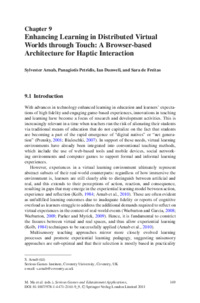Enhancing Learning in Distributed Virtual Worlds through TouchA Browser-based Architecture for Haptic Interaction
Zu finden in: Serious Games and Edutainment Applications (Seite 149 bis 167), 2012
|
 |
 Diese Seite wurde seit 7 Jahren inhaltlich nicht mehr aktualisiert.
Unter Umständen ist sie nicht mehr aktuell.
Diese Seite wurde seit 7 Jahren inhaltlich nicht mehr aktualisiert.
Unter Umständen ist sie nicht mehr aktuell.
 Zusammenfassungen
Zusammenfassungen

As technology evolves to support an increasingly diverse range of pedagogic approaches, various kinds of technology-driven interventions have already been integrated into conventional teaching methods, which include web-based tools and mobile devices, social networking environments and computer games. Such integration is capable of providing platforms to support formal and informal learning experiences, in both blended and standalone contexts. Innovations in teaching and learning, promoting a knowledge society, and supporting tremendous growth in demand for highly educated and skilled individuals, are influenced by the advances in technology as well as the emergence of a new generation for whom technology is an integral part of the learning process. This generation is able to migrate between existing and new technologies, building socially driven communities, and has high expectations of fidelity and dynamics from virtual learning environments.
However, as well as providing support for this fidelity, it is important to consider the pedagogic models that underpin innovative, technology-enhanced learning techniques. In order to increase and sustain engagement and receptiveness of the learner and to ensure effective learning outcomes, immersive learning facilitates the complete involvement of learners in their learning environment, harnessing techniques of exploration to enhance understanding of particular subjects. Whereas an encyclopaedic approach for understanding the characteristics of an ancient artefact requires a degree of intrinsic motivation on the part of the learner, examining and exploring the artefact first-hand via visual, social or tactile interaction can prove a more compelling and engaging experience, reaching wider student audiences more effectively.
Supporting experiential and exploratory models of learning, this chapter describes a method to combine different sensory elements of an immersive experience, to create an engaging and immersive multimodal approach to learning. By introducing tactile interfaces with visual and social, it is envisaged that learner perceptions will be more immersed and the gap between virtual and real spaces will be bridged by deeper involvement of the learner. By stimulating visual and tactile perceptions, real learning experiences may be more accurately replicated in a virtual world.
 Dieses Kapitel erwähnt ...
Dieses Kapitel erwähnt ...
 Tagcloud
Tagcloud
 Anderswo finden
Anderswo finden
 Volltext dieses Dokuments
Volltext dieses Dokuments
 |  Enhancing Learning in Distributed Virtual Worlds through Touch: A Browser-based Architecture for Haptic Interaction: Artikel als Volltext bei Springerlink ( Enhancing Learning in Distributed Virtual Worlds through Touch: A Browser-based Architecture for Haptic Interaction: Artikel als Volltext bei Springerlink ( : :  , 927 kByte; , 927 kByte;  : :  ) ) |
 Anderswo suchen
Anderswo suchen 
 Beat und dieses Kapitel
Beat und dieses Kapitel
Beat hat Dieses Kapitel während seiner Zeit am Institut für Medien und Schule (IMS) ins Biblionetz aufgenommen. Er hat Dieses Kapitel einmalig erfasst und bisher nicht mehr bearbeitet. Beat besitzt kein physisches, aber ein digitales Exemplar. Eine digitale Version ist auf dem Internet verfügbar (s.o.). Aufgrund der wenigen Einträge im Biblionetz scheint er es nicht wirklich gelesen zu haben. Es gibt bisher auch nur wenige Objekte im Biblionetz, die dieses Werk zitieren.









 Computerspiele
Computerspiele Innovation
Innovation Lernen
Lernen Motivation
Motivation Wahrnehmung
Wahrnehmung
 Biblionetz-History
Biblionetz-History